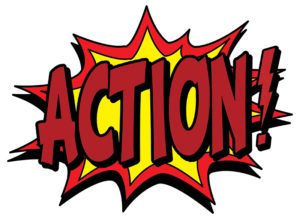 Readers like action and so do contest judges. An easy way to add action to your story is to add dialogue. Short sentences move the action forward. Run-on sentences are to be tracked down and killed during the editing process. First pages must have action and dialogue to draw in the readers’ interest. It’s sometimes called “the hook,” but no matter what you call it, a reader’s interest must be gained at the beginning and you need to keep them intrigued until the end.
Readers like action and so do contest judges. An easy way to add action to your story is to add dialogue. Short sentences move the action forward. Run-on sentences are to be tracked down and killed during the editing process. First pages must have action and dialogue to draw in the readers’ interest. It’s sometimes called “the hook,” but no matter what you call it, a reader’s interest must be gained at the beginning and you need to keep them intrigued until the end.
Dialogue can show the conflict with characters by having them not listen to what the other is saying. Or, dialogue can show their spoken words are hiding what they really feel toward the other person. If you master this technique, you’ll move your story forward and keep the action rolling, while engaging the imagination and the mind of the judges.
Let your dialogue or the accompanying action, such as body language, show the emotion. You don’t need to add, “he shouted” or “she growled.” Tags for dialogue should be action: She scratched her ear. He frowned at her reply. She scanned the room, her eyes flashing only to him sporadically. He adjusted his glasses.
Make sure the action occurs first, then the reaction. Wrong: “John jumped when the bomb went off.” Correct: “When the bomb went off, John jumped.”
Emotion drives fiction. The emotional impact the storyline has on the characters and how the reader responds to that emotional drama often determines how successful a writer told his/her story. Your reader (and contest judge) must be able to identify on an emotional level with your characters and their problems.
Everybody has a reason for their actions, including evil actions, and your readers like to understand the motivation of the characters. Giving your characters a past and allowing the readers a belief this character is capable of overcoming the obstacles in their path, makes them interesting.
Some writers begin their story or novel draft with the most emotional scene. It will be out of sequence, but it can establish the passion of the whole work. Something like this can help you write up to, and away from, that scene simply because it already exists. I’ve read Margaret Mitchell wrote the last chapter of Gone with the Wind first. Perhaps she felt if she knew where the characters were ending, she could then create deeper characters and get them to that ending more fully developed.
Transitions are a sink-hole a writer might use too often. Too many ellipses (…) or multiple uses of an emdash (—) are unnecessary. The best transitions are, “Three days later, they were still looking for the suspect” or “By the afternoon, they were exhausted.” Phrases like these move the story forward and keep the reader engaged.
Ellipses and emdashes are sometimes used to show a pause in the action. Many times, if you can use a gesture or physical description to show a pause, that serves to pause the action while being active for the reader. For example, used after some heated dialogue: She turned away from him and strode over to the counter. “Why would you say that?”
Description can slow or halt the action. As a member of a critique group, I was reading one of my group member’s excellent military action scene when all the action stopped with the detailed description of the helicopter and the pilot getting ready to start firing on them. All of the critique group members had the same experience with this scene and the writer subsequently corrected it. This is an excellent learning example of how description intruded into, and subsequently stopped, the action.
Previously published in the August, 2021 issue of Writers Monthly PDF.

Leave a Reply